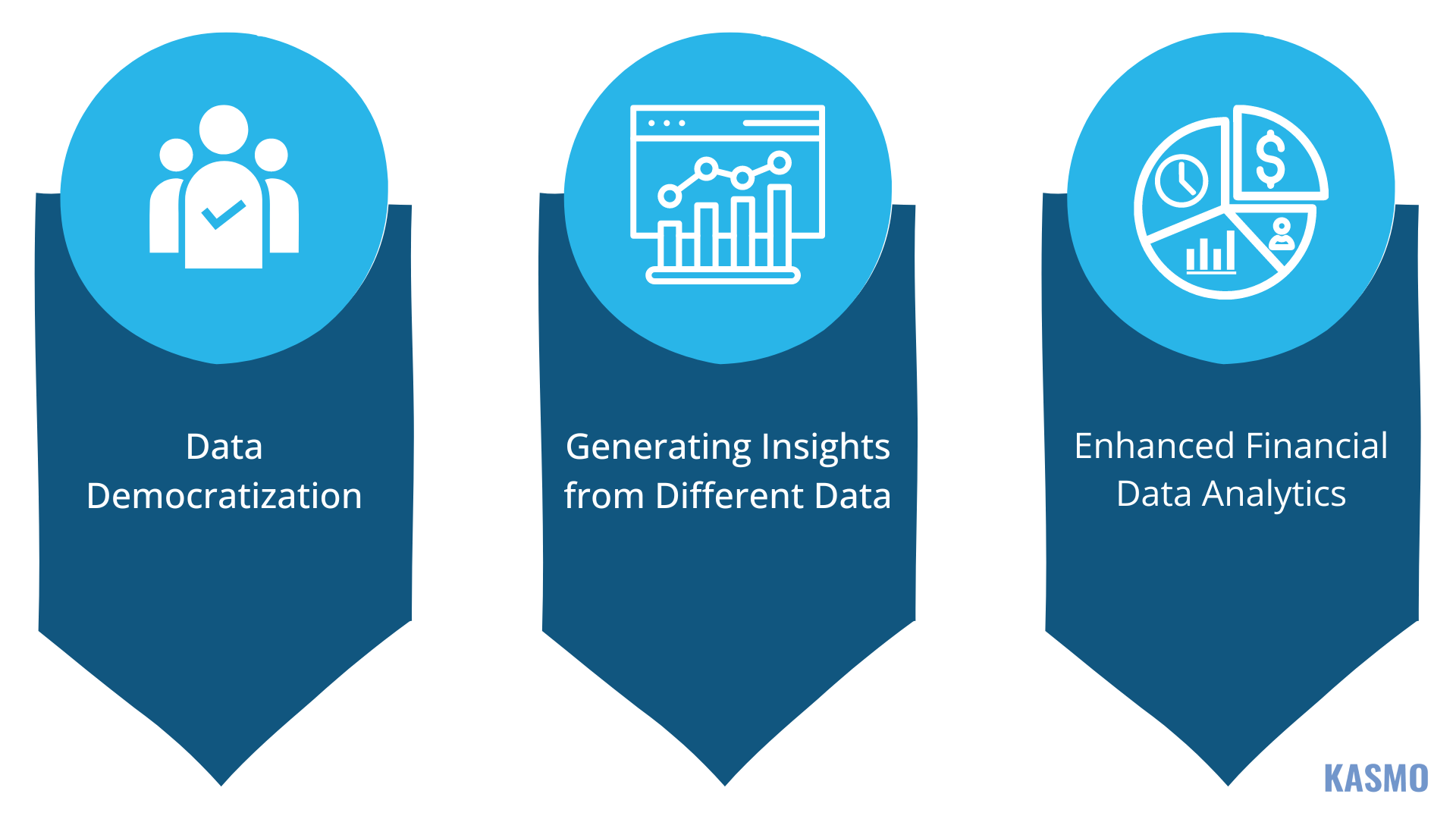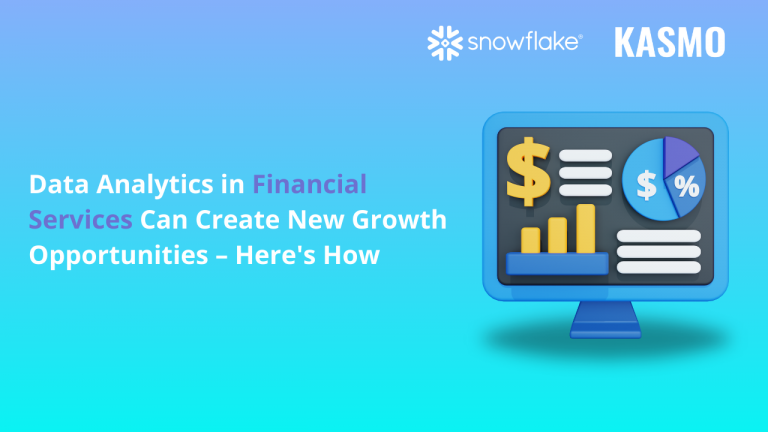Data analytics is becoming increasingly crucial in the finance sector. Globally, more businesses are leveraging data analytics to enhance their internal processes. According to Mckinsey, more than 90 percent of the top 50 banks around the world are using advanced analytics. The implementation of data analytics in financial services helps financial leaders gain deeper insights into their customers leading to more data-driven decisions.
Most significantly, data analytics in banking has created a huge impact. This new approach in banking services has helped leaders understand customer behavior and take data driven decisions. But why is data analytics in banking crucial and how does it help create new opportunities? Let’s find out!
Role of Data Analytics in Financial Services
Data analytics is revolutionizing the financial sector, influencing multiple aspects of the financial industry. It has become a fundamental element in offering a framework for decision-making, risk management, and enhancing customer satisfaction. Given the vast amounts of data in this sector, efficient analytical tools and techniques are essential to uncover complex patterns, forecast market trends, and make well-informed decisions.
The finance industry is significantly impacted by global events such as the pandemic, industry convergence, and rapid technological advancements driving digital growth. The profitability of financial services relies on risk elimination and close monitoring and interpretation of various market trends. Financial data and analytics enable banks to transform vast amounts of unstructured customer and transaction data into valuable insights, helping them understand key business aspects.
Financial services need fraud management solutions which are essential for maintaining reputation and ensuring business continuity. Human error and oversight are inevitable, making data analytics a smart choice for proactively identifying suspicious or fraudulent transaction patterns and consistently mitigating fraud risks.
Additionally, the highly competitive nature of the market creates challenges for the financial services. Whether in banking or insurance, customers seek better, more convenient, and relatable services. Data analytics in banking supports intelligent, data-driven decisions to discover new markets, design innovative products and services, enhance operational efficiency, and manage regulatory compliance.
Snowflake, one of the best cloud solutions present in the market, understands the competitive nature of the market and client demands. Its AI Data Cloud provides unique solutions for financial services by simplifying data architectures, deploying AI to enhance customer experience, strengthen risk management and empower businesses to streamline their workflows.
Popular Trends in Data Analytics for Financial Services
Financial services have started leveraging and analyzing massive amounts of data to enhance customer service and take more data-driven decisions. Let’s look at some of the popular trends in data analytics for financial services:
Moving Data to Cloud
Legacy on-premises systems face several challenges, including limited data visibility, unsecure access to critical third-party data, and poor scalability. Consequently, financial services companies are migrating to the cloud. The cloud offers unique capabilities that allow financial services companies to expand their operations without compromising security. Snowflake efficiently manages semi-structured data, which is crucial for real-time analytics.
Data Collaboration
Security is important while handling financial data. Financial services companies must make data available in real-time which enables customers to manage their accounts efficiently. Additionally, financial organizations need to collaborate with external agencies to provide services, such as credit agencies sharing information with banks for account and loan approvals.
To ensure secure data sharing, a centralized repository is essential. This approach eliminates the need for data extracts, which are both inefficient and pose security risks. Snowflake enables financial institutions to control data access, ensuring that all business units and partners have a single, secure version of the data.
Advance Data Strategies
Modern data strategies are revolutionizing financial services by enhancing analytics and business intelligence. Here’s how:

These strategies collectively empower financial services to make more informed and efficient decisions.
How Data Analytics in Financial Services Bringing in New Growth Opportunities?
Data analytics is transforming the way financial institutions operate. Here are five ways banks are leveraging data to drive growth and mitigate risks:
Cross-Selling and Upselling
By gaining a deeper understanding of how customers use their current financial products, banks can enhance their cross-selling and upselling strategies. For instance, analyzing customer data can help identify accounts which can be approached with higher membership levels or additional services.
Personalized Marketing and Product Recommendations
Targeting the right product to the right person at the right time is a complex challenge. Banking analytics programs analyze data sets to pinpoint high-potential prospects for new products. This data includes consumer demographics, purchasing behaviors, credit card statements, and usage patterns of existing financial products.
Advanced Credit Modeling
Traditional credit risk models often overlook valuable data. Modern analytics incorporate additional information from social media, loan history and credit ratings. This comprehensive approach enables financial leaders to take more informed decisions on extending credit.
Customer-Facing Virtual Assistants
AI-powered virtual assistants provide customers with quick answers and instant access to information on financial products and services. These assistants can also use recommendation engines to offer personalized product suggestions based on customer preferences and spending habits.
To help clients in the financial sector, our experts have crafted OLAF- a gen AI chatbot solution that can provide quick solutions in near real-time from a large repository of pre-fed documents in 107 languages, including 12 Indian languages. Talk to our experts and learn how you can use OLAF to enhance your financial operations.
Identifying Areas for Improvement and Automation
Data analytics in financial services can significantly reduce operating expenses by identifying inefficient internal processes. For example, by analyzing the time taken to process loan applications or open new accounts, banks can help enhance customer experience and boost productivity.
These strategies illustrate how data analytics is enabling banks to seize growth opportunities and minimize risks effectively.
Role of Data Analytics in Insurance
The insurance market is highly competitive. Customers are willing to change their service providers if they have a bad experience. Keeping this in mind, insurance companies can derive insights from their data to create tailored customer service. With advanced data analytics, risk assessment becomes easy. This helps insurers create tailored insurance which suits the needs and demands of their clients.
Snowflake AI Data Cloud helps understand risk factors. For example, in P&C insurance, underwriters can assess the risks associated with their clients and automate their underwriting process with Snowflake seamlessly. Insurance companies are also using data analytics to detect frauds which reduces the time in processing claims and enhances customer satisfaction.
Conclusion
Data analytics in financial services is helping to create new growth opportunities and enhance customer engagement. With the help of advanced data analytics in banking, financial professionals can understand how to handle risk management. Cloud migration ensures secure and improved manner to managing data. Implementing data analytics in banking helps in cross selling, tailor customer experience and optimize credit risk management.
Data analytics in insurance helps in detecting frauds and analyzing risks which can benefit the customer and organization. The future financial service firms depend on data analysis that enables them to make steady profits. Implementing data analytics is an intelligent strategy that allows organizations to meet the customers’ demands and use new trends.


